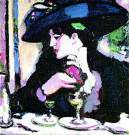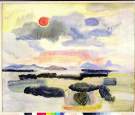 (54kb)
(54kb)
The Cramond Lioness
Pax Romana?
Roman and Celt in south-east Scotland
A new look at the archaeology of Romans and Celts in south
east Scotland featuring the first public display of the magnificent
Cramond Lioness sculpture.
The 2,000 year old treasure rescued from the river mud of the Forth
last year will be put on public display for the first time at the Pax
Romana? exhibition this summer at Edinburgh's City Art Centre.
The stone sculpture of a lioness, some 4'6" long and about 2' high, was found in January 1997 at Cramond, six miles from Edinburgh, and dates from the 2nd or early 3rd century AD. Similar finds from elsewhere in the Roman Empire are usually from military frontier areas such as the Rhineland and the Danube. Such sculptures are believed to form part of the decoration of large stone tombs of important Roman officials.
The find, of national importance, is the first example found in Scotland and of an unusual nature: usually the animal would be seen devouring a deer or other animal, but in this case the lioness is devouring a hunan being.
The Queen's and Lord Treasurer's Remembrancer decided to award custody of the lioness to the City Art Centre and to the National Museums of Scotland (NMS), into whose joint care it has now been placed. The award was made possible by a grant from the Heritage Lottery Fund, with assistance from the National Art Collections Fund, and contributions from the Friends of the City Art Centre and Museums and National Museums of Scotland.
The lioness will be seen in the context of an exhibition which looks at the relationship between Romans and the native population in Lothian and asks whether the discovery of the lioness changes our perceptions of that period in Scotland's history. Finds from other recent local excavations will also be on display, together with information on the process by which the lioness has been conserved at the Conservation Centre in Granton in readiness for public display.
 (93kb)
(93kb)
'The Blue Hat, Closerie des Lilas' by J D Ferguson
(1874 - 1961)
Full Of The Warm South
The Scottish Colourists and France
A major examination of the influence of France and French art
on the four Scottish colourists, Fergusson, Peploe, Cadell and Hunter,
from their early contact in the 1890s to the 1960s.
The Scottish Colourists had a close relationship with France and
French art from the 1890s onwards, and this relationship had a
profound influence on all four: JD Fergusson (1874 - 1961), SJ Peploe
(1871 - 1935), FCB Cadell (1883 - 1937) and Leslie Hunter (1877 -
1931). Their period of greatest innovation was the decade before the
First World War, when they all worked in France, absorbing the
revolutionary developments in French art of that time. Fergusson lived
in Paris from 1907 until 1914, while the others made numerous visits.
During this period they were producing paintings that were as radical
as anything by contemporary British artists and their work provides a
benchmark for much 20th century Scottish painting. Full of the
Warmth South draws on works from the City's collection, as well as
loans from public and private collections.
 (51kb)
(51kb)
'West Highland landscape' by Sir William Gillies (1898
- 1973)
First Among Equals
Gillies and his contemporaries
An exhibition of the work of Sir William Gillies, hailed as a
liberating force in Scottish art, shown alongside the work of Maxwell,
MacTaggart, Redpath and other colleagues and friends.
Sir William Gillies (1898 - 1973), born in Haddington, East Lothian,
was hailed as a liberating force in Scottish art. This exhibition,
drawn from the City's permanent collection, with loans from other
galleries and private collections, shows his work alongside that of
his contemporaries. These include former tutors and contemporaries at
Edinburgh College of Art, D M Sutherland, Henry John Lintott, Donald
Moodie, Adam Bruce Thomson, Penelope Beaton, as well as fellow
students or colleagues, William MacTaggart, John Maxwell, Robert
Henderson Blyth and David Foggie. Anne Redpath, a former student, was
encouraged by Gillies on her return to Scotland in 1934 from France,
and Lily McDougall's friendship and informed criticism encouraged
Gillies. Gillies, along with MacTaggart, founded the 1922 Group which
made a significant impact at a time witnessing a growth and interest
in Scottish art. It contained other notable artists, including William
Crozier, William Geissler and George C Watson.
 (51kb)
(51kb)
'Dunedin from Upper Junction' by George O'Brien
Southern Lights
150 years of Art in the Scottish
settlement of Otago, New Zealand
An exchange exhibition of historic and contemporary work from
Dunedin, commemorating the 150th anniversary of the arrival of
Scottish settlers at Otago, New Zealand.
Organised to celebrate the founding of the city of Dunedin by a group
of Scottish migrant settlers 150 years ago, Southern Lights
will trace the development of landscape art in the Otago region
between the early 19th century and the present day using paintings and
artifacts from colonial history to support. It will assemble some of
the finest examples of landscape art produced in New Zealand by many
of the foremost artists, including the 19th century watercolourist
George O'Brien, pioneers of New Zealand mid 20th century modernism
Rita Angus, Colin McCahon, Ralph Hotere and contemporary artists of
stature.
Themes to be explored in the exhibition will include the response of British and European artists to an unfamiliar landscape, the development of regional tendencies in New Zealand landscape painting, and the response of New Zealand artists to international influences. New Zealand's emergent multiculturism will be acknowledged as a major creative force in contemporary work.